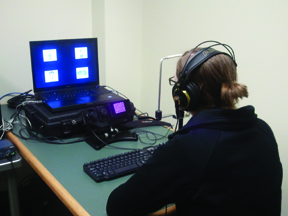Annie Tremblay
 Segmenting Speech into Words: What Eye Movements Can Tell Us about Foreign-Language Learning
Segmenting Speech into Words: What Eye Movements Can Tell Us about Foreign-Language Learning
In spoken language, the boundaries between words can be difficult to discern, and listeners rely on a variety of linguistic cues to distinguish words and decode meaning. Foreign-language (FL) learners must acquire this skill set to attain the ability to decode the speech stream in a native-like fashion; yet for many students, this is a difficult developmental process.
Professor Tremblay has been investigating this area as it applies to the learning of French, which uses cues to word boundaries that are very different from those in English. For example, consider the complexities presented by liaison in French, a phenomenon by which an otherwise silent consonant at the end of a word (e.g., –s in sans) is realized as the beginning of the following word (e.g., sans [z]elle). Here, the usual aural boundary of elle has become blurred into zelle; yet, the language provides prosodic, acoustic, phonemic, and syntactic cues to liaison, which guide listeners in their recognition of vowel-initial words in liaison contexts.
During her Center appointment, Professor Tremblay will attempt to learn whether some cues to liaison are more important than others, how French learners track these cues with increasing proficiency, and whether learners’ recognition of vowel-initial words in liaison contexts differs quantitatively or qualitatively from that of native speakers. To accomplish these aims, she will use the visual world eye-tracking technique, which provides exquisite time-course information about speech interpretation. The results should help to improve methods for teaching word-recognition skills and also identify the stages at which FL learners would benefit from instructional intervention.
